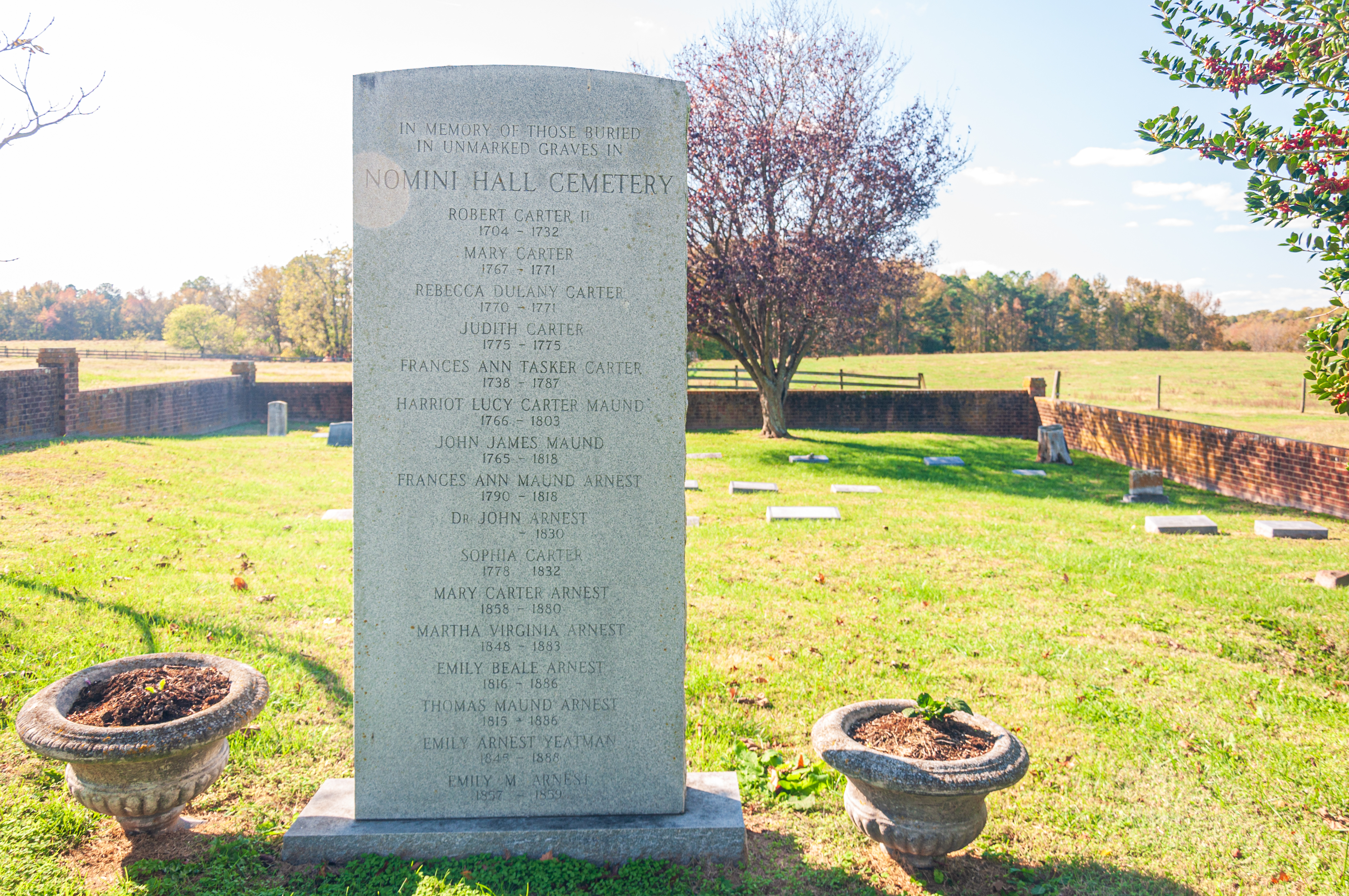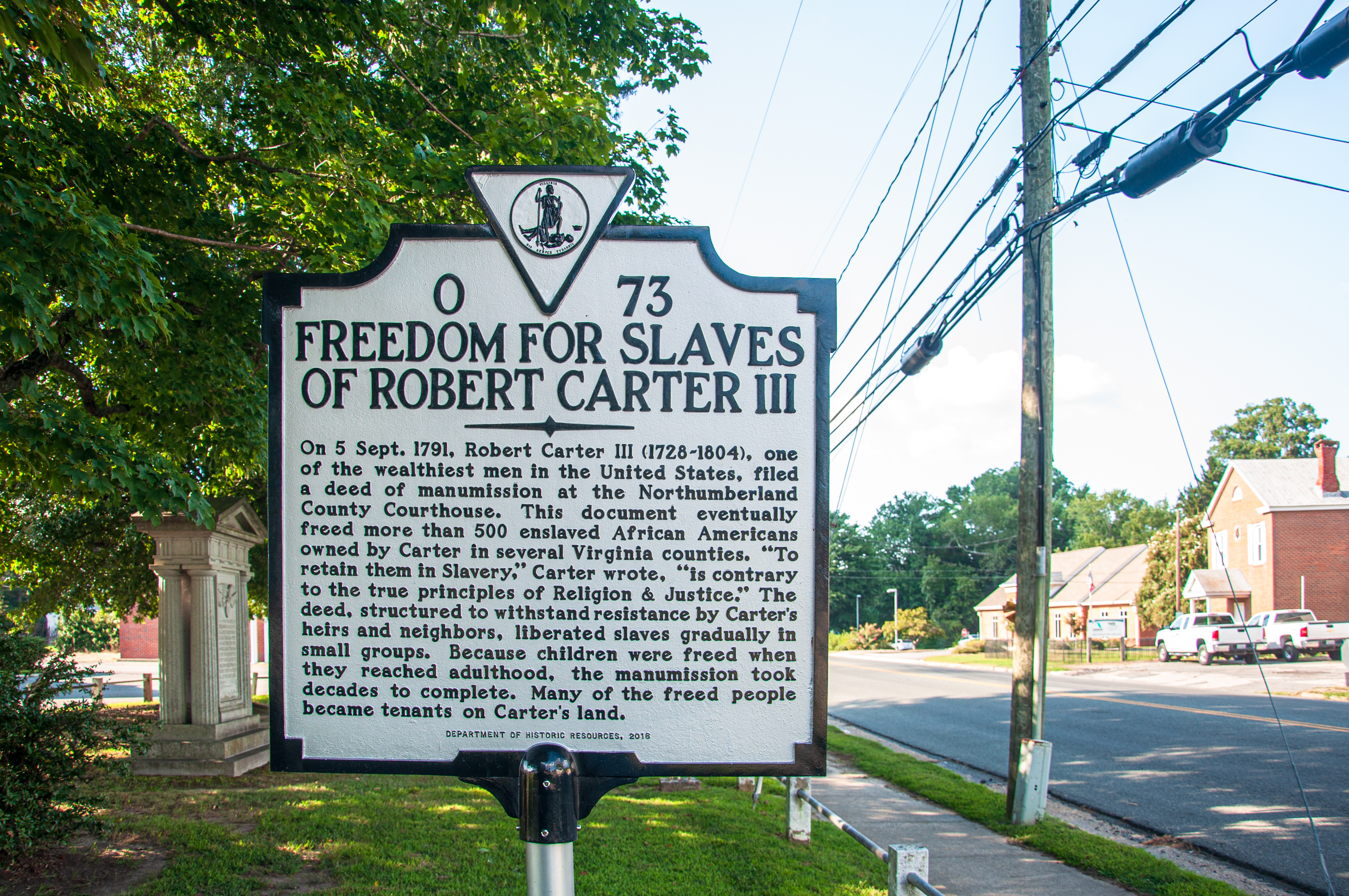The Carter legacy is second to none. Because they were involved in so many ventures, economic, political, and religious alike, their influence remains to be seen today.
John Carter’s descendants became titans of Virginia’s colonial and early American history. They inhabited, funded, and built major businesses that served to drive Virginia’s progression from a struggling outpost into a wealthy colony. Ironically, one Robert Carter used slave labor to build his wealth, while another Robert Carter used his wealth to free his slaves, such is the Carter complexity.
Because of that complexity, the Carter’s are a fascinating study for anyone. They were staunch Crown supporters, until the Crown appeared to harm them. They were slavers, until religious convictions haunted some. They were leading statesmen, until the new Country seemed to pass them by. But because they were so wealthy, and so familialy connected, the Carters would never vanish. The Commonwealth and indeed United States was built largely upon Carter thought and wealth, and as such earned their place at the top of Virginia’s First Family list.
LINKS TO THE PODCAST:

















SOURCES:
- Billings, Warren M.; Selby, John E.; and Tate, Thad W. Colonial Virginia: A History. White Plains, NY: KTO Press. 1986.
- Billings, Warren M. Sir William Berkeley and the Forging of Colonial Virginia. Baton Rouge, LA: LSU Press, 2004.
- Billings, Warren. A Little Parliament: The Virginia General Assembly in the Seventeenth Century. Richmond, VA: Library of Virginia, 2004.
- Brown, Katherine L. Robert “King” Carter: Builder of Christ Church. Irvington, VA: Historic Christ Church Heritage Books, 2001.
- Bruce, Phillip Alexander. Social Life of Virginia in the Seventeenth Century: An Inquiry into the Origin of the Higher Planting Class. New York: JP Bell Company, 1927.
- Carter, Robert III. A Man Named Robert: Lessons from the Life of America’s First Great Emancipator. Austin, TX: Cartier and Beaufort Press, 2022.
- Currer-Briggs, Noel. The Carters of Virginia: Their English Ancestry. Shopwyke Hall, Chichester, Sussex, England: Phillimore, 1979.
- Dabney, Virginius. Virginia: The New Dominion, A History from 1607 to the Present. Charlottesville, VA: University of Virginia Press, 1971.
- Dowdey, Clifford. The Virginia Dynasties: The Emergence of “King” Carter and the Golden Age. New York: Bonanza Books, 1969.
- Dowdey, Clifford. The Golden Age: A Climate for Greatness, 1732-1775. New York: Little Brown, 1970.
- Evans, Emory G. A “Topping People”: The Rise and Decline of Virginia’s Old Political Elite, 1680-1790. Charlottesville, VA: UVA Press, 2009.
- Fischer, David Hackett. Albion’s Seed: Four British Folkways in America (America: a cultural history). Oxford: Oxford University Press, 1989.
- Freeman, Douglas Southall. George Washington: A Biography. New York: Charles Scribners, 1957. (Specifically Volume 1).
- Horn, James. Adapting to A New World: English Society in the Seventeenth-Century Chesapeake. Chapel Hill, NC: University of North Carolina Press, 1994.
- Isaac, Rhys. Landon Carter’s Uneasy Kingdom: Revolution and Rebellion on a Virginia Plantation. Oxford: Oxford University Press, 2004.
- Isaac, Rhys. The Transformation of Virginia, 1740-1790. Chapel Hill, NC: UNC Press, 1999.
- Levy, Andrew. The First Emancipator: The Forgotten Story of Robert Carter, the Founding Father Who Freed His Slaves. New York: Random House, 2005.
- Mapp, Alfred J. Virginia Experiment: The Old Dominion’s Role in the Making of America, 1607-1781. Lincoln, NE: iUniverse, Inc., 2006.
- McCartney, Martha W. Virginia Immigrants and Adventurers: A Biographical Dictionary, 1607-1635. Baltimore, MD: Genealogical Publishing Co., 2007.
- Meade, William. Old Churches, Ministers and Families of Virginia. in Two Volumes. Philadelphia: J.B. Lippincott, 1891.
- Neill, Edward D. Virginia Carolorum: The Colony under the Rule of Charles The First and Second, A.D. 1625-A.D. 1685. Albany, NY: Joel Munsell’s and Sons, 1886.
- Pecquet du Bellet, Louise. Some Prominent Virginia Families, 4 Volumes. Lynchburg, VA: J.P. Bell Company, 1907.
- Rothbard, Murray N. Conceived in Liberty. Auburn, AL: Ludwig Von Mises Institute, 1999.
- Tyler, Lyon Gardiner. The Cradle of the Republic: Jamestown and the James River. Richmond, VA: The Hermitage Press, 1906.
- Wallace, George Selden. The Carters of Blenheim: A Genealogy of Edward and Sarah Champe Carter of “Blenheim” Albemarle County, Virgnia. Richmond, VA: Garrett and Massie, Inc., 1955.
- Walsh, Lorena S. Motives of Honor, Pleasure, and Profit: Plantation Management in the Colonial Chesapeake, 1607-1763. Chapel Hill, NC: University of North Carolina Press, 2010.
- Washburn, Wilcomb E. Virginia Under Charles I and Cromwell 1625-1660. Kindle Edition.
- Wertenbaker, Thomas Jefferson. Virginia Under the Stuarts: 1607-1688. New York: Russell and Russell, 1959.
- Wertenbaker, Thomas Jefferson. The Planters of Colonial Virginia. Kindle Edition.
- “Captain Thomas Carter and His Descendants: By One of Them, Dr. Joseph Lyon Miller, Thomas, West Virginia.” The William and Mary Quarterly 17, no. 4 (1909): 275–85.
- “Carter Ancestry.” The William and Mary Quarterly 9, no. 1 (1900): 34–37.
- Miller, Lyon. “Carter Genealogy.” The William and Mary Quarterly 18, no. 1 (1909): 47–58.
- Miller, Lyon. “Carter Genealogy.” The William and Mary Quarterly 18, no. 2 (1909): 89–103.
- Jos. Lyon Miller. “Carter Genealogy.” The William and Mary Quarterly 18, no. 4 (1910): 235–43.
- Jos. L. Miller. “Carter Genealogy.” The William and Mary Quarterly 19, no. 2 (1910): 116–37.
- Miller, Joseph L. “Carter Genealogy.” The William and Mary Quarterly 19, no. 3 (1911): 184–94.
- Jos. L. Miller. “Carter Genealogy.” The William and Mary Quarterly 20, no. 1 (1911): 38–51.
- The Fairfax Grant – http://www.vaplaces.org
- The Proprietors of the Northern Neck: Leeds Castle – http://www.culpepperconnections.com
SPECIAL LINKS:
- Historic Christ Church
- Department of Historic Resources: Corotoman
- Colonial Virginia Portraits: The Carter Family
- The Virginia Department of Historic Resources: Sabine Hall
- Nomini Hall Slave Legacy
- Oatlands:Historic House and Gardens
- Carter Mountain Orchard
- Blenheim Vineyards
- Carter Family Fold
- AP Carter Store and Museum
- Jimmy Carter Presidential Library and Museum







All photography used on this site is owned and copyrighted by the author unless otherwise noted. The Featured Image is of the Carter Family Crest. The gallery from top left to bottom right – 1. Robert Carter III Gravestone at Nomini Hall 2. Carter Family Marker at Nomini Hall 3. Nomini Hall Marker 4. Historic Marker at Heathsville commemorating Carter’s Deed of Gift 5. Robert Carter III Portrait at Oatlands 6. Carter’s Deed of Gift 7. Carter’s Grove Plantation 8. Robert Carter III House at Colonial Williamsburg 9. George and Elizabeth Carter Portraits at Oatlands 10. Nomini Hall Sketch 11. Historic Oatlands Plantation 12. Carter Family Fold 13. President Jimmy Carter 14. Blenheim Vineyards 15. Nanzatico 16. Sabine Hall 17. Carter Mountain 18. Shirley Plantation
Music used for this episode – Louis Armstrong and the Mills Brothers,”Carry Me Back to Old Virginia” available on Apple Music, and “Keep on the Sunny Side” by The Carter Family, also available on Apple Music.






















































